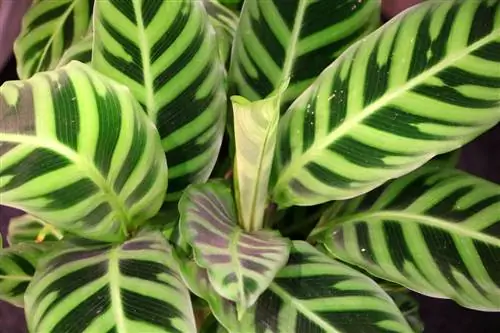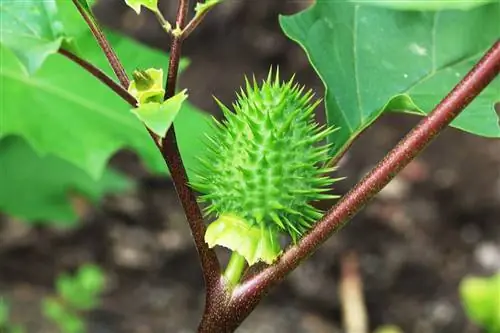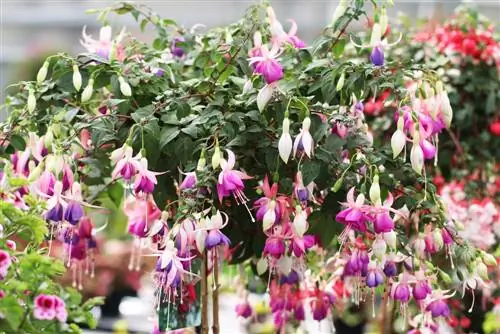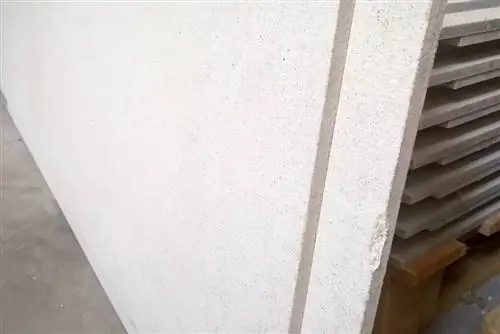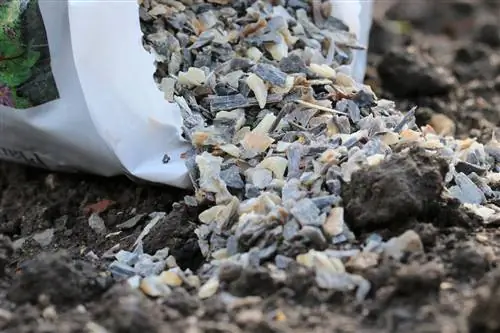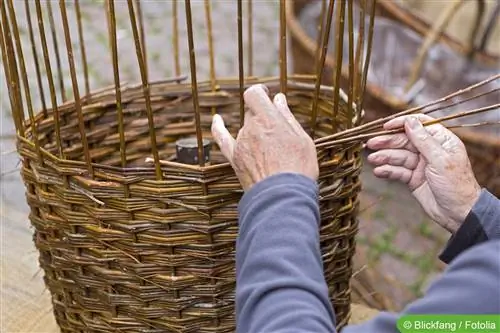- Author admin [email protected].
- Public 2023-12-17 03:39.
- Last modified 2025-01-24 12:45.
The Calathea is a member of the arrowroot family and has its origins in the Brazilian rainforest. The plant got its name 'Basket Marante' because the natives of the Brazilian rainforest wove baskets from the leaves of the Calathea.
The Calathea belongs to the large genus of tropical plants with interesting 10 to 60 cm long leaves. These leaves grow from a short, barely visible stem. The leaf shapes vary. They are sometimes elongated, sometimes lanceolate and also round. Because of their different leaf colors and shapes, these plants look extremely decorative. It is therefore becoming increasingly popular as a houseplant. The elegant leaf pattern makes the Calathea an exceptional houseplant. However, in order to successfully cultivate Calathea, the plant has some requirements in terms of care. Some species from the genus Calathea have also been used for medicinal purposes. However, today such use is discouraged.
Location
The basket marant is a tropical jungle plant. It also meets this requirement as a houseplant. To cultivate them successfully, their location, temperature and humidity must be similar to the conditions in their homeland. There it grows in the undergrowth. Here she is looking for a place in partial shade. If it is exposed directly to sunlight, the plant suffers and the leaves with their otherwise beautiful pattern fade.
Planting soil
The potting soil should be fibrous, rich in humus and well permeable to air. To retain moisture, perlite or Styrofoam balls should be added. Peat mixtures have also proven effective.
Temperature and humidity
Unfortunately, the beautiful basket marants are not very adaptable. Both the room temperature and the humidity therefore play a major role in cultivating this species in the room. During the period of main growth, the basket marante can tolerate temperatures of 22 °C and more. However, in winter, during the rest period, the temperature must not fall below 18°C. A flowering Calathea species needs a resting period at 15 °C for a short period of time. For both types, never place them on a cold windowsill so that the plant substrate does not cool down. To ensure consistently high humidity of around 70% without a greenhouse, the calathea should be sprayed daily. However, the water must be warm and low in lime. Water vessels placed in the room also release the required moisture through evaporation.
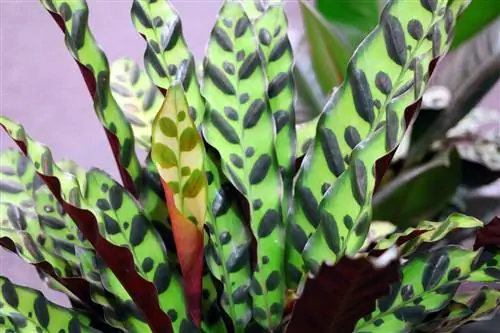
Watering water
The water for watering the Calathea must under no circumstances be cold because its roots are very sensitive. Room temperature water is comfortable for the plant. Tap water is acceptable, but low-lime, stale rainwater is better. The watering rule is: water as soon as the top layer of soil has dried slightly. In winter, when the room temperature is lower, watering is less. But the plant must not dry out even in winter.
Fertilization
The basket marant is quite undemanding when it comes to the supply of nutrients. It is sufficient to add a small amount of liquid fertilizer to the irrigation water every 14 days during the summer. A special fertilizer is not necessary.
Repotting
The time to repot has come when the roots of the plant become visible in the plant pot. This is best done in spring, before the plant sprouts new shoots and leaves after its winter dormancy. Since the basket marante is a shallow-rooted plant, you should choose a planter that is more wide than high.
Propagation
Propagation occurs by root division or shoot cuttings. Both variants are problem-free. When propagating by root division, the plant, including the roots, is cut with a sharp knife and immediately placed in a prepared pot. Water sufficiently. This creates the required climate and makes rooting easier. Shoot cuttings should have 2 to 4 leaves. The shoots are cut off close to the ground with a sharp knife and placed in humus-rich potting soil. An ambient temperature of 23 °C makes rooting easier with a humidity of 85 - 90%. If the ambient temperature is cooler, it takes longer for roots to form. After rooting, several shoot cuttings are placed in a planter so that the plants appear compact more quickly.
Cut
Even if the Kobmarante has some demands on care, it is really easy to care for when cutting. Only dried and wilting leaves are removed close to the ground. In the flowering species of the basket marante, the withered inflorescences are also cut off.
Care errors
- The Calathea must not be exposed to direct or indirect drafts.
- If the edges of the leaves turn brown, the plant is probably exposed to direct sunlight.
- Soil that is too dry and low humidity can also be the reason.
- If the leaves of the plant curl up, the location was chosen incorrectly or the plant needs more water.
- Overfertilization is shown by yellowing of the leaves. In this case, immediate repotting is required.
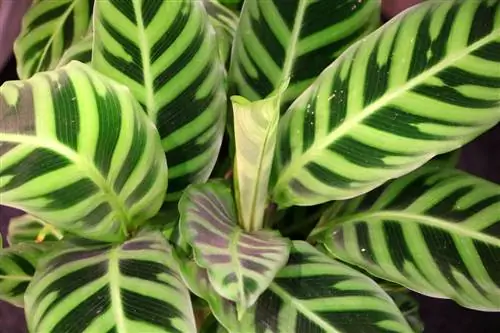
Diseases and pests
Pests almost never occur on the basket marante. Only spider mite infestations can occur, but this is the result of air that is too dry. The Calathea does not forgive care errors. If the air is too dry, the leaves curl up. Too little fertilizer will also quickly become visible on the plant. The leaves become light and lose their he althy appearance. If you only water your plants sporadically, you will not have luck with the Calathea. Forgetting to water will have fatal consequences. The leaves quickly become limp and the stems bend.
Tips for speed readers
- Over 300 species are known of the jungle plant that comes from South America.
- Decorative houseplant with large differences in growth, color, leaf shape and leaf pattern.
- Suitable for the winter garden.
- Makes demands on care and cultivation.
- Loves light shaded areas.
- Direct sunlight causes the markings on the leaves to fade.
- The planting substrate should be rich in humus and well-drained.
- Creating a tropical climate, high humidity and temperatures above 22°C.
- Wipe the leaves regularly and spray with low-lime water.
- Only a few species of the arrowroot family produce flowers.
- Propagation occurs through root division or head cuttings.
- The plant is not susceptible to diseases. Discoloration and wilted shoots are often an indication of incorrect care.
- Pruning is only carried out on brown inflorescences or withered leaves.
- Water containers attached to the heater ensure sufficient humidity
- If the leaves are cleaned regularly with a damp sponge, the pores on the top of the leaf are exposed again and receive the important oxygen.
What you should know about the basket marante in brief
The basket marant originally grows in tropical jungles and requires a correspondingly high level of humidity. Cultivating the plant can prove to be problematic because it is extremely maintenance-intensive. For this reason, the basket marante is more suitable for indoor gardeners who have the necessary patience and, above all, the necessary experience.
The plant got its name Korbmarante from the Indians. It was they who recognized the useful value of the plant and wove baskets from its leaves. The characteristic feature of the basket marante is its beautiful, patterned leaves, with each species having its own coloring or pattern that could hardly be more different. There are also some robust varieties among the Calathea species that are also suitable for practice by the less experienced indoor gardener.
Tip:
Shallow bowls are ideal for basket marantes, because the roots of the basket marantes grow in width rather than depth. You can use expanded clay balls to place a drainage layer in the pot; the soil should be loose. Ordinary potting soil can be easily loosened up with a little Styromull. Propagation occurs when repotting, by dividing the plant.

